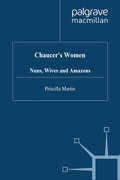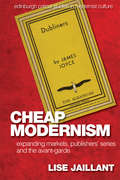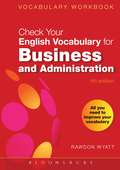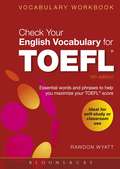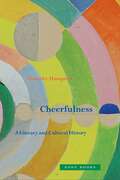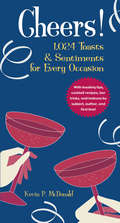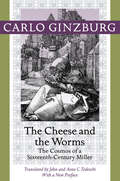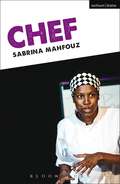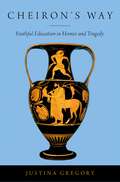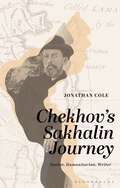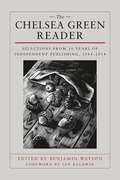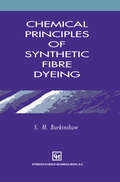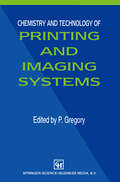- Table View
- List View
Chaucer's Women: Nuns, Wives And Amazons
by P. MartinIn this challenging study Priscilla Martin investigates the subjects of women, sex and gender in Chaucer's poetry. She argues convincingly that these are Chaucer's major subjects and that he presents them as an area of human experience fraught with problems. Women, instead of producing texts and meanings themselves, are trapped in the books and meanings of others, and so the Madonna and the courtly heroine, the nun and the wife, are familiar but questionable images of constructed femininity. '...an intelligent, sensitive, fresh and close reading which focuses upon Chaucer's women ... unconventional and subtle' - John J.McGavin, Times Higher Education Supplement
Cheap Modernism: Expanding Markets, Publishers’ Series and the Avant-Garde (Edinburgh Critical Studies in Modernist Culture)
by Lise JaillantWe often think of Mrs Dalloway or A Portrait of the Artist as a Young Man as difficult books, originally published in small print runs for a handful of readers. But from the mid-1920s, these texts and others were available in cheap format across Europe. Uniform series of reprints such as the Travellers’ Library, the Phoenix Library, Tauchnitz and Albatross sold modernism to a wide audience – thus transforming a little-read "highbrow" movement into a popular phenomenon. The expansion of the readership for modernism was not only vertical (from "high" to "low") but also spatial – since publisher’s series were distributed within and outside metropolitan centres in Britain, continental Europe and elsewhere. Many non-English native speakers discovered texts by Joyce, Woolf and others in the original language – a fact that has rarely been mentioned in histories of modernism. Drawing on extensive work in neglected archives, Cheap Modernism will be of interest to all those who want to know how the new literature became a global commercial hit.
Cheap Modernism: Expanding Markets, Publishers’ Series and the Avant-Garde (Edinburgh Critical Studies in Modernist Culture)
by Lise JaillantWe often think of Mrs Dalloway or A Portrait of the Artist as a Young Man as difficult books, originally published in small print runs for a handful of readers. But from the mid-1920s, these texts and others were available in cheap format across Europe. Uniform series of reprints such as the Travellers’ Library, the Phoenix Library, Tauchnitz and Albatross sold modernism to a wide audience – thus transforming a little-read "highbrow" movement into a popular phenomenon. The expansion of the readership for modernism was not only vertical (from "high" to "low") but also spatial – since publisher’s series were distributed within and outside metropolitan centres in Britain, continental Europe and elsewhere. Many non-English native speakers discovered texts by Joyce, Woolf and others in the original language – a fact that has rarely been mentioned in histories of modernism. Drawing on extensive work in neglected archives, Cheap Modernism will be of interest to all those who want to know how the new literature became a global commercial hit.
Check That Fact (Super Quick Skills)
by MorrisKnowing how to check and challenge information is essential for academic study – and our everyday lives. This practical guide shows you how to be savvy about using sources and improve your information literacy. Learn techniques for efficient and effective fact-checking Find out how to evaluate whether a source is credible Identify and challenge misinformation in academia and beyond. Super Quick Skills provide the essential building blocks you need to succeed at university - fast. Packed with practical, positive advice on core academic and life skills, you’ll discover focused tips and strategies to use straight away. Whether it’s writing great essays, understanding referencing or managing your wellbeing, find out how to build good habits and progress your skills throughout your studies. Learn core skills quickly Apply right away and see results Succeed in your studies and life. Super Quick Skills give you the foundations you need to confidently navigate the ups and downs of university life.
Check That Fact (Super Quick Skills)
by MorrisKnowing how to check and challenge information is essential for academic study – and our everyday lives. This practical guide shows you how to be savvy about using sources and improve your information literacy. Learn techniques for efficient and effective fact-checking Find out how to evaluate whether a source is credible Identify and challenge misinformation in academia and beyond. Super Quick Skills provide the essential building blocks you need to succeed at university - fast. Packed with practical, positive advice on core academic and life skills, you’ll discover focused tips and strategies to use straight away. Whether it’s writing great essays, understanding referencing or managing your wellbeing, find out how to build good habits and progress your skills throughout your studies. Learn core skills quickly Apply right away and see results Succeed in your studies and life. Super Quick Skills give you the foundations you need to confidently navigate the ups and downs of university life.
Check That Fact (Super Quick Skills)
by MorrisKnowing how to check and challenge information is essential for academic study – and our everyday lives. This practical guide shows you how to be savvy about using sources and improve your information literacy. Learn techniques for efficient and effective fact-checking Find out how to evaluate whether a source is credible Identify and challenge misinformation in academia and beyond. Super Quick Skills provide the essential building blocks you need to succeed at university - fast. Packed with practical, positive advice on core academic and life skills, you’ll discover focused tips and strategies to use straight away. Whether it’s writing great essays, understanding referencing or managing your wellbeing, find out how to build good habits and progress your skills throughout your studies. Learn core skills quickly Apply right away and see results Succeed in your studies and life. Super Quick Skills give you the foundations you need to confidently navigate the ups and downs of university life.
Check Your English Vocabulary for Business and Administration: All you need to improve your vocabulary (Check Your Vocabulary)
by Rawdon WyattThis workbook provides a range of exercises to help learners of English at intermediate level and above learn and review essential vocabulary used in business and administration. It is particularly suitable for students or overseas-trained business and administration staff who want to work in an English-speaking country, or whose work brings them into regular contact with English-speaking business people. It is also ideal for students who are planning to take the BEC Vantage / Higher exam, the TOEIC or one of the LCCI International Qualifications.
Check Your English Vocabulary for TOEFL: Essential words and phrases to help you maximize your TOEFL score
by Rawdon WyattThis workbook provides a resource for students studying towards the TOEFL® (Test of English as a Foreign Language) exam, which is a requirement for entry for non-native speakers of English at over 8,000 universities in 130 countries worldwide. Fully updated for this fourth edition, it includes a range of fun activities to help students build and improve their English vocabulary at TOEFL® level, and is suitable for both self-study and classroom use.
Checking Theory and Grammatical Functions in Universal Grammar (Oxford Studies in Comparative Syntax)
by Hiroyuki UraUra demonstrates that his theory of multiple feature-checking, an extension of Chomsky's Agr-less checking theory, gives a natural explanation for a wide range of data drawn from a variety of languages in a very consistent way with a limited set of parameters.
Cheerfulness: A Literary and Cultural History
by Timothy HamptonA timely story of a forgotten emotionCheerfulness: A Literary and Cultural History tells a new story about the cultural imagination of the West wherein cheerfulness — a momentary uptick in emotional energy, a temporary lightening of spirit — functions as a crucial theme in literary, philosophical, and artistic creations from early modern to contemporary times. In dazzling interpretations of Shakespeare and Montaigne, Hume, Austen and Emerson, Dickens, Nietzsche, and Louis Armstrong, Hampton explores the philosophical construal of cheerfulness — as a theme in Protestant theology, a focus of medical writing, a topic in Enlightenment psychology, and a category of modern aesthetics. In a conclusion on cheerfulness in pandemic days, Hampton stresses the importance of lightness of mind under the pressure of catastrophe. A history of the emotional life of European and American cultures, a breathtaking exploration of the intersections of culture, literature, and psychology, Cheerfulness challenges the dominant narrative of Western aesthetics as a story of melancholy, mourning, tragedy, and trauma. Hampton captures the many appearances of this fleeting and powerfully transformative emotion whose historical and literary trajectory has never before been systematically traced.
Cheerfulness: A Literary and Cultural History
by Timothy HamptonA timely story of a forgotten emotionCheerfulness: A Literary and Cultural History tells a new story about the cultural imagination of the West wherein cheerfulness — a momentary uptick in emotional energy, a temporary lightening of spirit — functions as a crucial theme in literary, philosophical, and artistic creations from early modern to contemporary times. In dazzling interpretations of Shakespeare and Montaigne, Hume, Austen and Emerson, Dickens, Nietzsche, and Louis Armstrong, Hampton explores the philosophical construal of cheerfulness — as a theme in Protestant theology, a focus of medical writing, a topic in Enlightenment psychology, and a category of modern aesthetics. In a conclusion on cheerfulness in pandemic days, Hampton stresses the importance of lightness of mind under the pressure of catastrophe. A history of the emotional life of European and American cultures, a breathtaking exploration of the intersections of culture, literature, and psychology, Cheerfulness challenges the dominant narrative of Western aesthetics as a story of melancholy, mourning, tragedy, and trauma. Hampton captures the many appearances of this fleeting and powerfully transformative emotion whose historical and literary trajectory has never before been systematically traced.
Cheers!: 1,024 Toasts & Sentiments for Every Occasion
by Kevin P. McDonaldCheers! is an indispensable A-to-Z of warm, funny, erudite, and sentimental sayings forevery possible occasion. Organized by category, Cheers! is more than a list of notable quotes and memorable toasts. It is full of useful advice on how to prepare a personalized message using the sayings in the book; deliver a toast without becoming flustered or, worse, running too long; and determine what words are appropriate for any given situation. An extended index and cross-references make Cheers! extremely easy to navigate, so finding the perfect words is a cinch.
The Cheese and the Worms: The Cosmos of a Sixteenth-Century Miller
by Carlo GinzburgThe Cheese and the Worms is an incisive study of popular culture in the sixteenth century as seen through the eyes of one man, the miller known as Menocchio, who was accused of heresy during the Inquisition and sentenced to death. Carlo Ginzburg uses the trial records to illustrate the religious and social conflicts of the society Menocchio lived in. For a common miller, Menocchio was surprisingly literate. In his trial testimony he made references to more than a dozen books, including the Bible, Boccaccio's Decameron, Mandeville's Travels, and a "mysterious" book that may have been the Koran. And what he read he recast in terms familiar to him, as in his own version of the creation: "All was chaos, that is earth, air, water, and fire were mixed together; and of that bulk a mass formed—just as cheese is made out of milk—and worms appeared in it, and these were the angels."Ginzburg’s influential book has been widely regarded as an early example of the analytic, case-oriented approach known as microhistory. In a thoughtful new preface, Ginzburg offers his own corollary to Menocchio’s story as he considers the discrepancy between the intentions of the writer and what gets written. The Italian miller’s story and Ginzburg’s work continue to resonate with modern readers because they focus on how oral and written culture are inextricably linked. Menocchio’s 500-year-old challenge to authority remains evocative and vital today.
The Cheese and the Worms: The Cosmos of a Sixteenth-Century Miller
by Carlo GinzburgThe Cheese and the Worms is an incisive study of popular culture in the sixteenth century as seen through the eyes of one man, the miller known as Menocchio, who was accused of heresy during the Inquisition and sentenced to death. Carlo Ginzburg uses the trial records to illustrate the religious and social conflicts of the society Menocchio lived in. For a common miller, Menocchio was surprisingly literate. In his trial testimony he made references to more than a dozen books, including the Bible, Boccaccio's Decameron, Mandeville's Travels, and a "mysterious" book that may have been the Koran. And what he read he recast in terms familiar to him, as in his own version of the creation: "All was chaos, that is earth, air, water, and fire were mixed together; and of that bulk a mass formedâ€�just as cheese is made out of milkâ€�and worms appeared in it, and these were the angels."Ginzburg’s influential book has been widely regarded as an early example of the analytic, case-oriented approach known as microhistory. In a thoughtful new preface, Ginzburg offers his own corollary to Menocchio’s story as he considers the discrepancy between the intentions of the writer and what gets written. The Italian miller’s story and Ginzburg’s work continue to resonate with modern readers because they focus on how oral and written culture are inextricably linked. Menocchio’s 500-year-old challenge to authority remains evocative and vital today.
Chef (Modern Plays)
by Sabrina MahfouzI cook here, create here,make here be as much of life as I canbecause outside of thisI'm not safe,I don't know the way.Chef tells the gripping story of how one woman went from being a haute-cuisine head chef to a convicted inmate running a prison kitchen. Leading us through her world of mouth-watering dishes and heart-breaking memories, Chef questions our attitudes to food, prisoners, violence, love and hope. Inspired by an interview Mahfouz conducted with celebrity chef Ollie Dabbous, Chef studies food as the ultimate art form taking stimulus from Dabbous's obsession with simplicity and making something the best it can be. Featuring Sabrina Mahfouz's distinct, lyrical style in abundance, Chef received its premiere at the Underbelly, Cowgate, during the 2014 Edinburgh Festival Fringe, winning a Fringe First, and was produced at the Soho Theatre, London, in June 2015.
Chef: That Boy; Dry Ice; Clean; Chef; Battleface; The Love I Feel Is Red; With A Little Bit Of Luck; Layla's Room; Rashida; Power Of Plumbing; This Is How It Was (Modern Plays)
by Sabrina MahfouzI cook here, create here,make here be as much of life as I canbecause outside of thisI'm not safe,I don't know the way.Chef tells the gripping story of how one woman went from being a haute-cuisine head chef to a convicted inmate running a prison kitchen. Leading us through her world of mouth-watering dishes and heart-breaking memories, Chef questions our attitudes to food, prisoners, violence, love and hope. Inspired by an interview Mahfouz conducted with celebrity chef Ollie Dabbous, Chef studies food as the ultimate art form taking stimulus from Dabbous's obsession with simplicity and making something the best it can be. Featuring Sabrina Mahfouz's distinct, lyrical style in abundance, Chef received its premiere at the Underbelly, Cowgate, during the 2014 Edinburgh Festival Fringe, winning a Fringe First, and was produced at the Soho Theatre, London, in June 2015.
Cheiron's Way: Youthful Education in Homer and Tragedy
by Justina GregoryThis book studies the social and ethical formation of youthful figures in Homer, Sophocles, and Euripides. Every fictional character comes with a past attached, a presumed personal history that is both implicit and explicit; for the youthful heroes and heroines of epic and tragedy, early education figures significantly in that past. Cheiron's Way takes as its point of departure the words of Homer's Phoenix to Achilles, who claims, "I made you the man you are" as he pleads with his former pupil to let go of his anger. The book begins by exploring topics relevant to heroic and tragic education: age classes, rites of passage, verbal modes of instruction, social conditioning, mentoring, peer role models, and the controversial balance between nature and nurture. It introduces the first teacher in the Greek tradition, Cheiron the centaur, who founded a school for young heroes in his Thessalian cave and instructed Achilles, Jason, and others with mixed success. Next it turns to the Iliadic Achilles, who achieves maturity by way of successive crises-a crisis of disillusionment with the assumptions that shaped his heroic education, followed by a crisis of empathy for his adversary-and who becomes an influential prototype for tragedy. Examination of the Odyssey suggests that while Odysseus received a normative heroic upbringing and Nausicaa internalizes social expectations for young women, Telemachus is more of an outlier. In tragic representations of education Sophocles' Ajax and Neoptolemus replicate the Achillean pattern only partially and unsuccessfully, as does Euripides' Hippolytus; only Achilles and Iphigenia in Euripides' Iphigenia in Aulis achieve an emotional maturity commensurate with the Iliadic Achilles'. Yet all these texts confirm, as elegantly argued in this book, the perennial lure, despite uncertain results, of the educational enterprise for communities, students, and teachers.
Cheiron's Way: Youthful Education in Homer and Tragedy
by Justina GregoryThis book studies the social and ethical formation of youthful figures in Homer, Sophocles, and Euripides. Every fictional character comes with a past attached, a presumed personal history that is both implicit and explicit; for the youthful heroes and heroines of epic and tragedy, early education figures significantly in that past. Cheiron's Way takes as its point of departure the words of Homer's Phoenix to Achilles, who claims, "I made you the man you are" as he pleads with his former pupil to let go of his anger. The book begins by exploring topics relevant to heroic and tragic education: age classes, rites of passage, verbal modes of instruction, social conditioning, mentoring, peer role models, and the controversial balance between nature and nurture. It introduces the first teacher in the Greek tradition, Cheiron the centaur, who founded a school for young heroes in his Thessalian cave and instructed Achilles, Jason, and others with mixed success. Next it turns to the Iliadic Achilles, who achieves maturity by way of successive crises-a crisis of disillusionment with the assumptions that shaped his heroic education, followed by a crisis of empathy for his adversary-and who becomes an influential prototype for tragedy. Examination of the Odyssey suggests that while Odysseus received a normative heroic upbringing and Nausicaa internalizes social expectations for young women, Telemachus is more of an outlier. In tragic representations of education Sophocles' Ajax and Neoptolemus replicate the Achillean pattern only partially and unsuccessfully, as does Euripides' Hippolytus; only Achilles and Iphigenia in Euripides' Iphigenia in Aulis achieve an emotional maturity commensurate with the Iliadic Achilles'. Yet all these texts confirm, as elegantly argued in this book, the perennial lure, despite uncertain results, of the educational enterprise for communities, students, and teachers.
Chekhov: A Biographical and Critical Study (Routledge Library Editions: Russian and Soviet Literature #2)
by Ronald HingleyThis book, first published in 1950, is a balanced examination of Chekhov’s life and work, a critical analysis of his stories and plays set against the background of his life the Russia of the day. Using Chekhov’s works, biographical details, and, more importantly, his many thousands of letters, this book presents a comprehensive critical study of the writer and the man.
Chekhov: A Biographical and Critical Study (Routledge Library Editions: Russian and Soviet Literature #2)
by Ronald HingleyThis book, first published in 1950, is a balanced examination of Chekhov’s life and work, a critical analysis of his stories and plays set against the background of his life the Russia of the day. Using Chekhov’s works, biographical details, and, more importantly, his many thousands of letters, this book presents a comprehensive critical study of the writer and the man.
Chekhov’s Sakhalin Journey: Doctor, Humanitarian, Writer
by Jonathan ColeChekhov often said that 'I am a doctor by trade and sometimes I do literary work in my free time', a surprising claim, given his status as a giant of 20th century drama. This literary-biographical study uncovers new sides to him, as both a medical professional and humanitarian, and tells the story of Chekhov's trip to Sakhalin Island in the harsh wastes of Siberia.Anton Chekhov practiced medicine for most of his life and engaged in humanitarian work which took him away from writing for months. He placed one such trip though, across the unforgiving terrain of Siberia to write about the penal island of Sakhalin, above all others. Chekhov's Sakhalin Journey, written by a neuroscientist and practicing clinician, uses this trip and Chekhov's own account of it to shed light on hitherto overlooked aspects of his life. In doing so, it shows that to understand the man we need his medicine as well as his literature, and we need to assess his life from his perspective as well as ours.
Chekhov’s Sakhalin Journey: Doctor, Humanitarian, Writer
by Jonathan ColeChekhov often said that 'I am a doctor by trade and sometimes I do literary work in my free time', a surprising claim, given his status as a giant of 20th century drama. This literary-biographical study uncovers new sides to him, as both a medical professional and humanitarian, and tells the story of Chekhov's trip to Sakhalin Island in the harsh wastes of Siberia.Anton Chekhov practiced medicine for most of his life and engaged in humanitarian work which took him away from writing for months. He placed one such trip though, across the unforgiving terrain of Siberia to write about the penal island of Sakhalin, above all others. Chekhov's Sakhalin Journey, written by a neuroscientist and practicing clinician, uses this trip and Chekhov's own account of it to shed light on hitherto overlooked aspects of his life. In doing so, it shows that to understand the man we need his medicine as well as his literature, and we need to assess his life from his perspective as well as ours.
The Chelsea Green Reader: Selections from 30 Years of Independent Publishing, 1984-2014
by Ben Watson Ian BaldwinChelsea Green, the Vermont-based independent publisher, has always had a nose for authors and subjects that are way ahead of the cultural curve, as is evident in this new anthology celebrating the company’s first thirty years in publishing. The more than one hundred books represented in this collection reflect the many distinct areas in which we have published–from literature and memoirs to progressive politics, to highly practical books on green building, organic gardening and farming, food and health, and related subjects–all of which reflect our underlying philosophy: "The politics and practice of sustainable living." The Chelsea Green Reader offers a glimpse into our wide-ranging list of books and authors and to the important ideas that they express. Interesting and worth reading in their own right, the individual passages when taken as a whole trace the evolution of a highly successful small publisher–something that is almost an oxymoron in these days of corporate buyouts and multinational book groups. From the beginning, Chelsea Green's books were nationally recognized, garnering positive reviews, accolades, and awards. We’ve published four New York Times bestsellers, and our books have set the standard for in-depth, how-to books that remain relevant years–often decades–beyond their original publication date. "Chelsea Green was born from a single seed: the beauty of craft. Craft in writing and editing, in a story well told, or a thesis superbly expressed," writes cofounder and publisher emeritus Ian Baldwin in the book's foreword. Today, craft continues to inform all aspects of our work–design, illustration, production, sales, promotion, and beyond. It has even informed our business model: In 2012, Chelsea Green became an employee-owned company. With the rise of the Internet, new media platforms, and a constantly shifting bookselling landscape, the future of publishing is anything but predictable. But if Chelsea Green's books prove anything, it is that, despite these challenges, there remains a hunger for new and important ideas and authors, and for the permanence and craftsmanship of the printed word. Today our ongoing mission is stronger than ever, as we launch into our next thirty years of publishing excellence.
Chemical Principles of Synthetic Fibre Dyeing
by S.M. BurkinshawSynthetic fibres are widely used for many applications, with their colour being of major commercial importance. This extensively referenced book provides a comprehensive account of the physical chemistry of the dyeing of synthetic fibres and microfibres.
Chemistry and Technology of Printing and Imaging Systems
by P. GregoryPrinting and imaging has a major impact on everyone. From the obvious examples of newspapers, magazines and comics through to photographs, currency and credit cards, and even the less obvious example of compact discs, everyone is familiar with the end products of printing and imaging. Until recently, the major printing and imaging technologies have been impact printing and silver halide photography. Important impact printing technologies are offset lithography, gravure, flexography and screen printing. All these technologies, including silver halide photography, are mature and have changed little over the past few decades. In contrast, the phenomenal growth of silicon chip technology over the past 15 years or so has spawned a new era of printing and imaging systems, the so-called non impact (or electronic) printers. Not all the non-impact printing technologies are of equal commercial importance. Some, like diazotype and conventional photolithography, are mature and are declining in importance. Other technologies, though relatively new, have not achieved notable commercial success. Electro graphy and magnetography fall into this category. The remaining tech nologies such as optical data storage (the technology used in compact discs), thermography (the technology used in electronic photography), ink jet printing and electrophotography are the non-impact printing tech nologies that are both modern and which have achieved remarkable commercial success, especially ink-jet printing and electrophotography.
